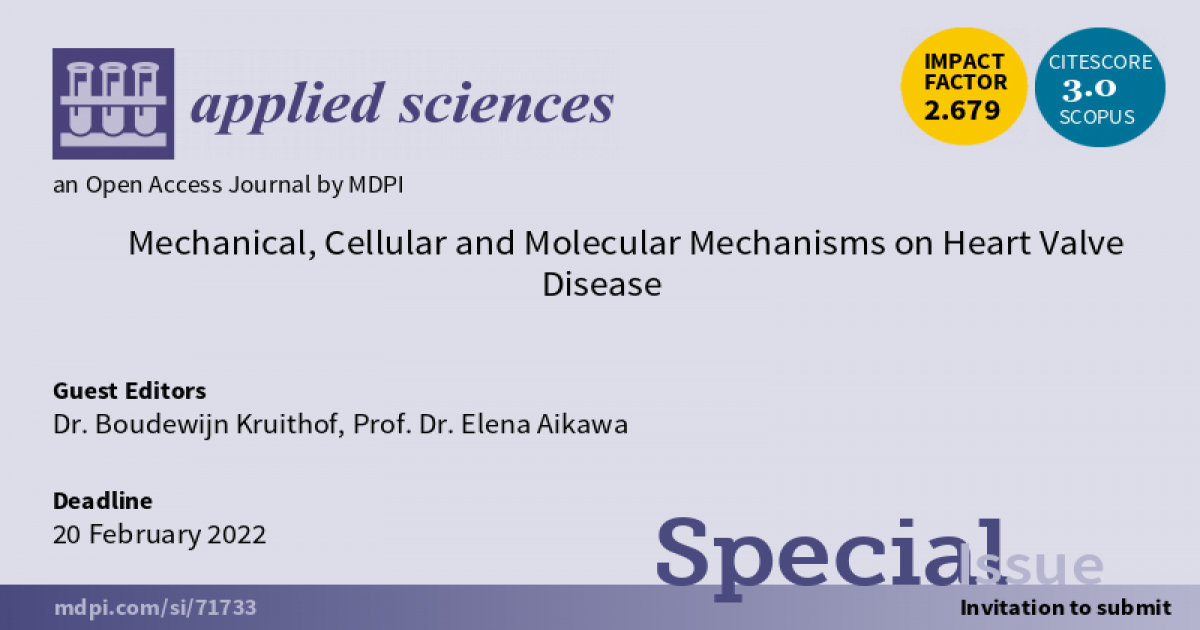- 2.5Impact Factor
- 5.5CiteScore
- 17 daysTime to First Decision
Mechanical, Cellular and Molecular Mechanisms on Heart Valve Disease
This special issue belongs to the section “Applied Biosciences and Bioengineering“.
Special Issue Information
Dear Colleagues,
Heart valve disease affects about 2.5% of the population, with increasing prevalence at older age. No pharmacological treatment exists as of yet, and surgical repair or replacement is the only therapeutic option. Although our understanding of the molecular and cellular mechanisms involved in heart valve disease has greatly expanded in recent years, the complexity of the valvular structure and dynamics and the multifactorial nature of heart valve disease have hampered the development of nonsurgical treatments. The cardiac valves consist of a heterogeneous cell population which resides in a highly organized extracellular matrix. The positioning of the valves in the heart and their specific configuration exposes each part of the leaflet to unique mechanical stresses during the cardiac cycle. Insight into the interaction between the valvular cells, extracellular matrix, and its mechanical environment is crucial for the understanding of the pathophysiology of heart valve disease.
In this Special Issue, we welcome original research papers and review articles on the mechanical, cellular, and molecular mechanisms involved in heart valve disease with an emphasis on the interactions between valvular cells and their environment, new model systems, and new targets for pharmacological therapies.
Dr. Boudewijn Kruithof
Prof. Dr. Elena Aikawa
Guest Editors
Manuscript Submission Information
Manuscripts should be submitted online at www.mdpi.com by registering and logging in to this website. Once you are registered, click here to go to the submission form. Manuscripts can be submitted until the deadline. All submissions that pass pre-check are peer-reviewed. Accepted papers will be published continuously in the journal (as soon as accepted) and will be listed together on the special issue website. Research articles, review articles as well as short communications are invited. For planned papers, a title and short abstract (about 250 words) can be sent to the Editorial Office for assessment.
Submitted manuscripts should not have been published previously, nor be under consideration for publication elsewhere (except conference proceedings papers). All manuscripts are thoroughly refereed through a single-blind peer-review process. A guide for authors and other relevant information for submission of manuscripts is available on the Instructions for Authors page. Applied Sciences is an international peer-reviewed open access semimonthly journal published by MDPI.
Please visit the Instructions for Authors page before submitting a manuscript. The Article Processing Charge (APC) for publication in this open access journal is 2400 CHF (Swiss Francs). Submitted papers should be well formatted and use good English. Authors may use MDPI's English editing service prior to publication or during author revisions.
Keywords
- heart valve disease
- aortic valve
- mitral valve
- calcific aortic valve disease
- mitral valve prolapse
- valvular interstitial cells
- mechanical environment
- hemodynamics
- myxomatous valves

Benefits of Publishing in a Special Issue
- Ease of navigation: Grouping papers by topic helps scholars navigate broad scope journals more efficiently.
- Greater discoverability: Special Issues support the reach and impact of scientific research. Articles in Special Issues are more discoverable and cited more frequently.
- Expansion of research network: Special Issues facilitate connections among authors, fostering scientific collaborations.
- External promotion: Articles in Special Issues are often promoted through the journal's social media, increasing their visibility.
- e-Book format: Special Issues with more than 10 articles can be published as dedicated e-books, ensuring wide and rapid dissemination.

